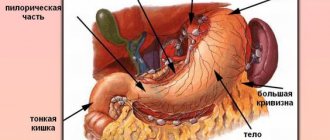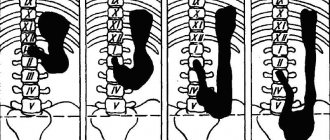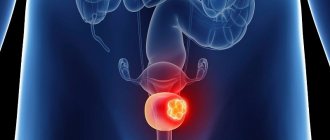Gastric cancer is a malignant tumor that develops from the cells of the gastric mucosa. It ranks fifth in prevalence among all types of cancer. As a rule, people over 40 years of age get sick. The main method of treatment is surgical removal of the entire stomach or its affected part.
- Causes of stomach cancer
- Classification of stomach cancer: what is it like?
- Symptoms: how does stomach cancer manifest?
- How to diagnose the disease in time? What is screening and why is it important?
- What diagnostic methods can a doctor prescribe?
- Modern principles of gastric cancer treatment
- What is the prognosis for stomach cancer?
- Prices for treatment of stomach cancer at stages 1-4
Causes of stomach cancer
The exact causes of stomach cancer are unknown. DNA mutations occur in the mucous membrane of the organ, resulting in “wrong” cells that can acquire the ability to grow uncontrollably. Why this happens is not entirely clear. But risk factors are well studied - conditions that increase the risk of stomach cancer.
Heredity and stomach cancer
Some people carry a “time bomb” hidden in their genes. Sometimes not even one. This is confirmed by some facts:
- If a close relative (parents, siblings, children) of a person is diagnosed with stomach cancer, the risk is increased by about 20%.
- Men get sick more often than women. It is difficult to say what exactly this is connected with, but it can be assumed that a difference between male and female genes is involved.
- Japanese who migrated to the United States suffer from stomach cancer less often than their compatriots, but more often than “native” Americans. This suggests that the matter is not only in the nature of nutrition, but also in heredity. The main suspect is a gene called RNF43.
- Carcinoma, the most common type of stomach cancer, is more common in people with blood type A (II), which they, of course, received along with their genes.
- The risks are increased in some hereditary diseases: pernicious anemia (3-6 times), hypogammaglobulinemia, non-polyposis colon cancer.
- The incidence of stomach cancer increases after age 70, thought to be due to the accumulation of unwanted mutations in body cells as we age.
Stomach cancer and diet
The role of nutrition in the occurrence of malignant tumors of the stomach has been well studied. Risks are increased by large amounts of salt, starch, nitrates, and some carbohydrates. People who eat a lot of salted, smoked, pickled foods and few vegetables and fruits get sick more often.
Stomach cancer and bad habits
Smoking approximately doubles the risk of stomach cancer. Scientists in the UK believe that approximately every fifth case is related to smoking. When a person inhales tobacco smoke, part of it enters the stomach, and the harmful substances it contains damage the cells of the mucous membrane. The higher the smoking experience and the number of cigarettes daily, the higher the risks.
Scientific research shows that drinking alcohol also increases the risk of developing stomach cancer. For example, in 2021, scientists conducted a meta-analysis of studies performed from 1995 to 2015 and found that people who regularly drink alcohol have a 1.39 times higher risk of developing malignant tumors in the stomach than non-drinkers.
The European Prospective Study of Cancer (EPIC Study) found that alcohol was responsible for 57,600 cases of upper gastrointestinal, colon and liver cancer in men and 21,500 cases in women included in the study. Among these patients, 57% of men regularly consumed more than two alcoholic drinks per day, and among women, 80% consumed more than one alcoholic drink per day. “One drink” (standard drink) is a quantity of alcohol in any form that contains 14 grams of pure ethyl alcohol. This is approximately 350 ml of beer (5%), 150 ml of wine (12%) or 40-50 ml of spirits (40%).
Helicobacter pylori (H. Pylori) and stomach cancer
H. Pylori is a bacterium that can cause peptic ulcers and chronic atrophic gastritis. It is currently considered an important factor in the development of gastric cancer. With Helicobacter pylori infection, the likelihood of a malignant tumor in the stomach increases 4 times. This pathogen is found in half of the removed tumors.
Other risk factors
- Peptic ulcer disease. Research data on this matter is contradictory. If the ulcer is located in the body of the stomach, the risk of cancer increases almost 2 times. With a lower ulcer, the risks do not appear to be increased.
- Adenomatous polyps of the mucous membrane.
- Familial adenomatous polyposis is a disease caused by a mutation in the APC gene and leads to the appearance of many polyps in the stomach and intestines. This slightly increases the risk of cancer.
- Gastric surgery increases the risk of cancer by 2.5 times. This is due to the fact that the stomach produces less hydrochloric acid, and bacteria that produce nitrites multiply more actively in it, and bile backflows from the small intestine. Typically, malignant tumors appear 10-15 years after surgery.
- Social and financial situation: the risk increases with low income, living in an overcrowded apartment, without amenities, in an unfavorable area.
- Other oncological diseases: cancer of the esophagus, prostate, bladder, mammary glands, ovaries, testicles.
- Menetrier's disease (hypertrophic gastropathy) is characterized by the growth of the gastric mucosa, the appearance of folds in it and a decrease in the production of hydrochloric acid. The pathology is rare, so it is unknown how often it leads to stomach cancer.
- Workers in the coal, metallurgical and rubber industries are at increased risk.
- Immunodeficiency increases the likelihood of developing cancer and gastric lymphoma.
Risk factors and prevention
These are all things that increase a person's chance of developing cancer. And although risk factors often influence the development of the disease, most of them do not directly cause cancer. Knowing your risk factors and discussing them with your doctor can help you make more informed lifestyle and health care choices.
The following factors increase your risk of developing cancer:
- Age. The tumor most often occurs in people over 55 years of age. Most patients diagnosed with stomach cancer are over 60-70 years of age.
- Floor. Men are twice as likely to develop cancer.
- Bacteria. A fairly common bacterium called Helicobacter pylori, or H. pylori, causes inflammation and stomach ulcers. It is also considered one of the main causes of cancer. There is a test for H. pylori, and the infection can be treated with antibiotics.
- Family history/genetic predisposition. People who have had a parent, child, or sibling with cancer are at higher risk of the disease. Some inherited genetic disorders, such as hereditary diffuse gastric cancer, Lynch syndrome, hereditary breast and ovarian cancer, and familial adenomatous polyposis, increase the risk of developing a tumor.
- Race/ethnicity. Cancer is more common in blacks, Hispanics and Asians than in whites.
- Diet. A diet high in salt is associated with an increased risk of developing cancer. This includes foods preserved by drying, smoking, salting or pickling, as well as foods high in salt. Eating fresh fruits and vegetables may help reduce your risk.
- Previous surgeries or health conditions. People who have had gastric surgery, pernicious anemia, or achlorhydria have an increased risk of developing cancer. Pernicious anemia is a significant decrease in the number of red blood cells caused by the stomach being unable to properly absorb vitamin B12. Chlorhydria is a lack of hydrochloric acid in gastric juice.
- Professional factors. Exposure to certain types of dust and fumes increases the risk of developing pathology.
- Tobacco and alcohol. Tobacco use and alcohol abuse may increase the risk of developing stomach cancer.
- Obesity. Excess body weight increases the risk of developing cancer in men. It is not clear whether obesity increases a woman's risk of developing stomach cancer.
Classification of stomach cancer: what is it like?
Malignant tumors of the stomach, according to the WHO International Histological Classification, are divided into 11 types, depending on which cells they originate from. The predominant cancer is from glandular cells that line the mucous membrane and produce mucus - adenocarcinoma. It accounts for 90-95% of all cases. There are also tumors from immune (lymphoma), hormone-producing (carcinoid) cells, and from nervous tissue.
One of the oldest classifications divides malignant tumors of the stomach into 3 types:
- Intestinal. As the name suggests, in the surroundings of the tumor there is intestinal metaplasia, that is, the gastric mucosa becomes similar to the intestinal mucosa. This type of cancer is more common in older people and has a more favorable prognosis. This is a typically “Japanese” type of cancer.
- Diffuse. Tumor cells spread along the wall of the stomach, they are surrounded by normal mucous membrane.
- Mixed.
Gastric adenocarcinoma
Stages of stomach cancer
Stomach cancer is divided into early (initial) and advanced. In early cases, the tumor does not grow deeper than the mucous membrane and submucosa. Such tumors are easier to remove (including endoscopically) and have a better prognosis. The TNM classification is also used, which takes into account the size and growth into different tissues of the primary tumor (T), metastases in regional (nearby) lymph nodes (N), and distant metastases (M).
Classification depending on the condition of the primary tumor (T):
- Tx – primary tumor cannot be assessed;
- T0 – the primary tumor is not detected;
- T1 – severe dysplasia of mucosal cells, the tumor is located in the superficial layer of the mucous membrane (“cancer in situ”);
- T2 – the tumor has grown into the muscle layer of the organ wall;
- T3 – cancer has reached the serous (outer) lining of the stomach, but has not grown into it;
- T4 – the tumor has grown into the serosa (T4a) and into adjacent structures (T4b).
Classification depending on the presence of lesions in regional lymph nodes:
- Nx – it is impossible to evaluate metastases in the lymph nodes;
- N0 – no metastases were detected in regional lymph nodes;
- N1 – 1-2 lymph nodes are affected;
- N2 – tumor cells have spread to 3-6 lymph nodes;
- N3 – metastases in 7-15 (N3a) or 16 or more (N3b) lymph nodes.
Classification depending on the presence of distant metastases:
- M0 – no distant metastases detected;
- M1 – distant metastases detected.
Adenocarcinoma is divided into 4 stages:
- Stage I (T1M0N0 – stage Ia; T1N1M0, T2N0M0 – stage Ib). The tumor is located within the mucous membrane and submucosa and does not grow deep into the wall of the stomach. Sometimes cancer cells are found in nearby lymph nodes.
- Stage II (T1N2M0, T2N1M0, T3N0M0 – stage IIa; T1N3aM0, T2N2M0, T3N1M0, T4aN0M0 – stage IIb). The tumor grows into the muscle layer of the stomach wall and spreads to the lymph nodes.
- Stage III (T2N3aN0, T3N2M0, T4aN1M0, T4aN2M0 – stage IIIa; T1N3bM0, T2N3bM0, T3N3aM0, T4aN3aM0, T4bN1M0 – stage IIIb; T3N3bM0, T4aN3bM0, T4bN3aM0 – stage IIIc). The cancer has grown through the entire wall of the stomach and, possibly, has spread to neighboring organs and managed to more strongly affect the nearby lymph nodes.
- Stage IV (any T and N, M1). There are distant metastases.
Introduction
Digestion process
The stomach is located in the upper part of the abdominal cavity. It plays a vital role in digestion. After swallowing, food passes down a muscular tube (esophagus) that connects the throat to the stomach. When food enters the stomach, it mixes and produces gastric juice, which helps break it down. The bolus of food then moves to the small intestine for further digestion.
Types of stomach cancer
Stomach cancer begins when healthy tissue cells change and grow uncontrollably. It is necessary to distinguish between cancerous and benign tumors. Cancerous (malignant) can grow, affecting neighboring organs and systems. Benign – grows, but does not spread to other tissues.
The main form of gastric cancer is adenocarcinoma. This means that the tumor has developed in the glandular tissue lining the inside of the stomach. Other types of cancer include lymphoma, gastric carcinoma and neuroendocrine tumor, but these are rare.
Gastric cancer metastases
Cancer cells can break away from the mother tumor and migrate to other parts of the body in various ways:
- With the lymph flow, they can enter the lymph nodes of the abdominal cavity, and from them - into the lymph nodes of the supraclavicular region - Virchow's metastasis. Metastasis to the lymph nodes surrounding the rectum is called Schnitzler metastasis.
- Through the bloodstream, cancer cells most often spread to the liver, less often to the lungs.
- Cancer cells can also spread throughout the abdominal cavity. If they settle on the ovaries, a Krukenberg metastasis is formed, in the navel - a metastasis from Sister Mary Joseph. Rarely with stomach cancer, metastases are found in the brain and bones.
Diagnostics
- The most informative endoscopy is esophagogastroscopy, which allows you to immediately take at least 6 pieces of damaged tissue for examination.
- Supplementing gastroscopy with ultrasound examination - endosonography will quite clearly determine the depth of penetration of the cancer process into the gastric wall.
- The extent of damage to the walls of the organ is determined by polypositional X-ray contrast examination.
- An abdominal CT scan will reveal metastases in the lymphatic system and clarify the involvement of surrounding tissues and organs in the malignant process.
- A mandatory examination before surgery is laparoscopy, which detects peritoneal carcinomatosis.
Symptoms: how does stomach cancer manifest?
In the early stages, stomach cancer either has no symptoms at all or is disguised as other diseases: gastritis, exacerbation of peptic ulcer. Worsening of appetite and pain in the pit of the stomach rarely make people immediately suspect cancer and rush to the hospital. Usually they limit themselves to diet and taking advertised “stomach relief” pills. If a person already suffers from a peptic ulcer, he may perceive the first signs of stomach cancer as another exacerbation of the ulcer. And later, when cancer is diagnosed, the patient recalls that the manifestations were “not the same as always.”
There is a so-called “small sign syndrome” - it was formulated by one of the founders of Soviet oncology, Alexander Ivanovich Savitsky. If you are concerned about similar symptoms, this is a reason to go to the doctor and get checked:
- Unexplained weakness and increased fatigue.
- Poor appetite.
- Decreased performance.
- Weight loss.
- “Stomach discomfort”: unpleasant sensations that make even your favorite food no longer enjoyable.
Subsequently, brighter, “screaming” signs increase. They depend on which part of the organ the tumor is located in:
- Dysphagia. It occurs when the tumor compresses the junction of the stomach and the esophagus. First it becomes difficult to swallow solid food, then liquid food.
- Vomiting recently eaten food. Characteristic of tumors in the lower part of the stomach, at the junction with the duodenum.
- Persistent heartburn.
- Constant pain in the stomach area that radiates to the back. They do not pass day or night.
- Weight loss.
- Abdominal enlargement. It occurs due to ascites, an accumulation of fluid in the abdominal cavity.
- Under the pit of your stomach you can feel and feel a hard protruding formation. This is a tumor that has grown together with the anterior abdominal wall.
Over time, the process of ulceration and decay begins in the tumor, and gastric bleeding develops. It manifests itself in the form of black, tarry stool, vomit that looks like “coffee grounds” or contains admixtures of scarlet blood. If a person loses a lot of blood, he becomes pale, weak, and dizzy. Some people are diagnosed with cancer when they are brought to the clinic in this condition in an ambulance.
Make an appointment with an oncologist
Symptoms
Oncology is not detected at an early stage, as it does not cause any specific symptoms. Below are the symptoms of stomach cancer.
- Indigestion or heartburn
- Pain and discomfort in the abdominal area
- Nausea and vomiting, particularly vomiting solid food soon after eating
- Diarrhea or constipation
- Bloating after eating
- Loss of appetite
- Feeling like food is stuck in the throat while eating
Symptoms of advanced cancer include:
- Weakness and fatigue
- Bloody vomiting and blood in stool
- Unexplained weight loss
It is important to remember that complaints can also be caused by many other diseases, in particular a stomach virus or ulcer.
How to diagnose the disease in time? What is screening and why is it important?
Statistics show that in 75% of cases, stomach cancer is diagnosed at an advanced stage, when the tumor has time to grow into neighboring tissues and metastasize. It is difficult to treat such patients, and the prognosis is usually unfavorable. Typically, severe symptoms indicate that the cancer has already spread throughout the body.
How to check your stomach for cancer:
Screening—regular examinations of people who do not experience any symptoms—helps in the early stages. As a screening study, gastroscopy is used - an endoscopic examination during which a flexible tube with a miniature video camera and a light bulb at the end is inserted into the stomach. How effective is gastroscopy? This is best demonstrated by the Japanese experience. The prevalence of stomach cancer in Japan is very high, and its mortality rate is one of the lowest in the world. This was achieved through the introduction of mass screening.
Euroonco clinics have special screening programs that help diagnose various cancer diseases in a timely manner. Visit your doctor to learn about your risks and get personalized screening recommendations.
Follow-up and control
Treatment for people diagnosed with cancer does not end when active therapy is completed. Your doctors will continue to check to see if the cancer has returned, monitor any possible side effects, and monitor your overall health. This is called follow-up. It includes regular medical examinations and medical tests. Doctors aim to track recovery over the following months and years.
Relapse control
The purpose of follow-up is to monitor relapse. The disease recurs because small areas of undetected cancer cells may remain in the body. Over time, these cells may increase in size until they appear on test results or cause signs and symptoms. During follow-up, a doctor familiar with your medical history can provide you with personalized information about your risk of recurrence. Your doctor will ask specific health questions. Some may need to have blood tests or imaging tests as part of regular follow-up, but follow-up recommendations depend on several factors, including the type and stage of cancer initially diagnosed and the type of treatment received.
What diagnostic methods can a doctor prescribe?
In addition to gastroscopy, a stomach cancer diagnostic program may include:
- X-ray, before which the patient is given a contrast solution to drink. In this case, the contours of the stomach are clearly visible in the photographs.
- Computed tomography, positron emission tomography.
- Diagnostic laparoscopy. This is an operation during which a laparoscope with a miniature video camera and special instruments are inserted into the patient’s abdomen through holes. The procedure helps to assess how far beyond the stomach the process has spread.
- Biopsy. The doctor obtains a sample of the suspicious tissue and sends it to the laboratory for examination under a microscope. This diagnostic method helps to diagnose cancer as accurately as possible and determine the type of cancer. A biopsy can be performed during gastroscopy or surgery.
Rehabilitation
Recovery after gastrectomy requires enormous effort from the patient and medical staff. The patient is given special catheters to drain the postoperative wound, introduce nutrients into the intestines and remove waste products. In the first stages, anesthesia is used.
As the patient recovers, he begins to eat normally. First, he is given clean water, then liquid food is introduced into the stomach through a catheter or he is transferred to independent feeding. A strict diet must be followed for a long time, often until the end of life.
Modern principles of gastric cancer treatment
The main treatment method for stomach cancer is surgery. The extent of the operation depends on the stage at which the tumor is detected. If it has not yet spread deep into the wall of the organ, endoscopic resection is performed - removal of the affected area using an instrument inserted through the mouth, as during gastroscopy.
With a subtotal gastrectomy, the part of the organ affected by the tumor process is removed. In later stages, the entire organ must be removed along with surrounding tissue. In this case, the esophagus is connected to the small intestine. If the lymph nodes in the abdominal cavity are affected by metastases, they also need to be removed.
In advanced cases, when cure is impossible, palliative surgery is performed. The surgeon removes the affected part of the stomach to relieve the patient's condition.
Radiation therapy for stomach cancer is:
- neoadjuvant - performed before surgery to reduce the size of the tumor and facilitate its removal;
- adjuvant - to destroy cancer cells that remain in the body after surgery.
The most common side effects of radiation therapy when irradiating the abdominal area are nausea, indigestion, and diarrhea.
Chemotherapy can also be adjuvant or neoadjuvant. It is often combined with radiation therapy. Chemoradiation therapy can become the main treatment method for metastatic cancer in the later stages, when the prognosis is poor, but there is an opportunity to alleviate symptoms and prolong the patient's life.
In some cases, targeted drugs are effective: trastuzumab, ramucirumab, imatinib, sunitinib, regorafenib. But they are suitable only in cases where tumor cells have certain molecular genetic properties.
Treatment methods
“Standard of care” means the best known methods of treatment. Clinical trials are also recommended as cancer care. They help test a new treatment approach. Doctors want to know whether this treatment is safe, effective and perhaps more acceptable than standard treatment. Clinical trials may test a new drug, a combination of proven treatments, or variations in dosage of standard drugs or other treatments. Clinical trials are an option for cancer care at every stage of the process. Your doctor can help you consider all of your treatment options.
Treatment Overview
The interdisciplinary team develops an overall treatment plan. For stomach cancer, such teams may include the following doctors:
- Gastroenterologist – specializes in the gastrointestinal tract, in particular the stomach and intestines;
- Surgeon or surgical oncologist - specializes in treating cancer through surgery;
- Oncologist – specializes in treating cancer with medications;
- Radiation oncologist – specializes in treating cancer using radiation therapy;
- Histologist – specializes in interpreting laboratory tests and evaluating cells, tissues and organs to diagnose disease;
- Radiologist – specializes in using imaging techniques to diagnose disease.
Treatment for stomach cancer consists of surgery, radiotherapy, chemotherapy, targeted therapy or immunotherapy. Treatment options and recommendations depend on several factors, including the type and stage of cancer, possible negative reactions of the body, personal preferences, and the presence of chronic pathology. For the treatment of oncology, a combination of different techniques is most often recommended. Treatment of the tumor can be complicated due to the fact that it is often detected only in the last stages.
Take the time to explore all of your treatment options and be sure to ask questions about anything you don't understand. Discuss with your doctor the purpose of each type of therapy and what you should expect during treatment. These conversations are called “shared decision making.”
Surgery
This is the elimination of neoplasm of adjacent healthy tissue through surgery. The type of operation depends on the stage of the oncological process.
For very early stage (T1a) cancer, some doctors may recommend a nonsurgical treatment called endoscopic mucosal resection. In the early stages (stage 0 or I), when the cancer is still only in the stomach, surgery is used to remove the part of the stomach containing the cancer and nearby lymph nodes. This is called a subtotal or partial gastrectomy. In a partial gastrectomy, the surgeon sutures a small part of the stomach to the esophagus or small intestine.
If the cancer has grown into the outer wall of the stomach, with or without spreading to lymph nodes, surgery plus chemotherapy or chemotherapy with radiotherapy may be used. The surgeon may perform a subtotal gastrectomy or a total gastrectomy, which means removing the entire stomach. In a total gastrectomy, the surgeon connects the esophagus directly to the small intestine.
Gastrectomy is a major surgical procedure that entails unpleasant consequences. After this surgery, the patient is allowed to eat only small amounts of food at a time. A common side effect is a group of symptoms called dumping syndrome, including cramps, nausea, diarrhea and dizziness after eating. This occurs when food enters the small intestine too quickly. Your doctor can suggest ways to avoid complex symptoms and prescribe medications to control them. Symptoms usually improve or disappear after a few months, but for some people they appear constantly. Patients who have had their entire stomach removed may require regular vitamin B12 injections as they are no longer able to absorb it through the stomach.
Regional lymph nodes are often removed during surgery because cancer may have spread to them. This is called lymphadenectomy.
Radiation therapy
This is the use of high-energy X-rays or other particles to destroy cancer cells. The treatment regimen consists of several procedures carried out over a certain period of time. Patients with stomach cancer are given external beam radiotherapy, which uses radiation from a machine outside the body. Radiation therapy may be given before surgery to shrink the tumor or after surgery to kill remaining cancer cells.
Side effects from radiation therapy include fatigue, mild skin reactions, upset stomach, and loose stools. Most side effects disappear soon after treatment ends, but long-term effects may occur.
Drug therapy
Systemic therapy is the introduction of a drug into the bloodstream to destroy cancer cells.
Common systemic treatments include inserting an intravenous (IV) catheter into a vein using a needle or swallowing (oral) tablet form of the medication.
For stomach cancer, the following types of systemic therapy are used:
- Chemotherapy
- Targeted therapy
- Immunotherapy
Depending on a number of factors, the patient is recommended either one type of systemic therapy or a combination of several types at the same time. They may also be part of a treatment plan that includes surgery and/or radiation therapy.
It is also important to tell your doctor if you are taking other medications or dietary supplements. Herbal drugs, dietary supplements, and other medications interact with cancer drugs.
Chemotherapy is the use of drugs that destroy tumor cells, preventing them from growing and dividing.
A chemotherapy regimen (or regimen) usually consists of several cycles of treatments. They are carried out over a certain period of time. At the same time, the patient can receive 1 drug or a combination of different drugs.
The goal of chemotherapy is to destroy cancer cells left behind after surgery, slow the growth of tumor cells, or reduce symptoms associated with cancer. It can also be combined with radiotherapy. Side effects of chemotherapy depend on the individual characteristics of the body and the dosage of the drug. Fatigue, severe weakness, risk of infection, dyspepsia, baldness, and decreased appetite may be observed.
Targeted therapy is a treatment that targets specific cancer genes, proteins, or tissue environments that promote cancer growth and survival. Targeted therapy blocks the growth and spread of cancer cells while limiting damage to healthy ones.
Not all tumors have the same targets. To develop the most effective treatment, your doctor will perform tests to identify genes, proteins, and other factors in your tumor.
The following targeted therapy is used in the treatment of stomach cancer:
- HER2-targeted therapy. Some cancers may produce too much of a protein called human epidermal growth factor receptor 2 (HER2). This type of cancer is called HER2-positive cancer.
- Antiangiogenic therapy. It is aimed at stopping angiogenesis, that is, the process of creating new blood vessels. For tumor development, nutrients supplied through blood vessels are needed. Therefore, the goal of antiangiogenic therapy is to “deplete” the tumor.
Immunotherapy
Biological therapy (another name) is designed to enhance natural defenses against cancer. It uses substances produced by the body or produced in a laboratory to improve, direct, or restore immune system function.
Different types of immunotherapy can cause different negative reactions. Common side effects include skin reactions, flu-like symptoms, diarrhea, and weight changes.
Physical, emotional and social consequences of cancer
Cancer and its treatment cause physical symptoms and side effects, as well as emotional, social and financial consequences. Managing all of these effects is called palliative or supportive care. It is an important part of your treatment, just as important as treatments to slow, stop, or eliminate cancer.
Palliative care aims to improve well-being during treatment by controlling symptoms and supporting the non-medical needs of patients and their families. Anyone, regardless of age, type or stage of cancer, can receive such care. It is most effective if started immediately after diagnosis of the disease.
Palliative care is varied and often includes medications, dietary changes, relaxation techniques, emotional and spiritual support, and other treatments (chemotherapy, surgery, or radiation therapy).
Metastatic stomach cancer
If a tumor spreads to another part of the body, beyond the organ in which it originated, doctors call it metastatic cancer. Experts have different views on the optimal standard treatment plan. Clinical trials may also be considered as a treatment option.
The goal of treatment at this stage is usually to prolong the patient's life and eliminate symptoms, since metastatic gastric cancer is considered incurable. Any treatment, including chemotherapy or radiation therapy, is considered palliative. The main type of cancer care is chemotherapy. It is important to note that studies have shown that the use of palliative chemotherapy can improve both quality and length of life.
Remission and the possibility of recovery
This is a condition in which cancer cannot be detected in the body and there are no symptoms.
Remission can be temporary or permanent. This uncertainty has many people worried that the cancer may return. In many cases, remission is temporary, so it is important to discuss with your doctor the likelihood of the cancer returning. Understanding your risk of relapse and treatment options will help you feel more prepared.
If the cancer comes back after initial treatment, it is called recurrent. May reappear in the same location (local), nearby (regional), or in a different location (distant). After the tests, you should discuss further cancer care with your doctor. The treatment plan often includes the treatments described above, such as surgery, chemotherapy, and radiation therapy, but they may be used in other combinations or at different intensities. Sometimes, if the size of the recurrent tumor is small or its spread is limited, that is, if the recurrence is localized, you may be offered surgical treatment.
If treatment doesn't help
Cancer cannot always be cured. If the disease cannot be cured or controlled, the disease is called progressive or terminal.
A diagnosis like this is very stressful, and many people find it very difficult to discuss advanced cancer. It is important to talk openly and honestly with your care team, explaining your feelings, preferences, and fears. The medical team has the specialized skills, experience and knowledge to support patients, their families and is always ready to help.
What is the prognosis for stomach cancer?
The prognosis for stomach cancer depends on the stage of the tumor at which the diagnosis was made and treatment began. The chances of stable remission are highest if the tumor has not grown beyond the mucous membrane and submucosa. With metastases, the prognosis is usually unfavorable.
In oncology, there is such an indicator as five-year survival rate. It shows what percentage of patients remain alive for 5 years. The period is quite long; in a certain sense, it can be equated to recovery. The five-year survival rate for different stages of stomach cancer is:
- Stage I - 57-71%;
- Stage II - 33-46%;
- Stage III - 9-20%;
- Stage IV - 4%.
Some numbers and facts:
- Experts from the World Health Organization (WHO) say that stomach cancer kills 754,000 people worldwide every year.
- In the 21st century, the prevalence of the disease is decreasing, but varies from country to country. Thus, for every patient from the UK, there are two from Russia and three from Japan.
- Gastric cancer is the fifth most common cancer among other cancers, but the third most common cause of death.
- One of the leading countries in terms of cancer prevalence is Japan, largely due to the nature of the diet.
Euroonko clinics use the most modern methods of treating stomach cancer and other oncological diseases. Even if the prognosis is unfavorable, this does not mean that nothing can be done to help the patient. Our doctors know how to relieve symptoms, ensure an acceptable quality of life, and prolong life
Classification and varieties
In terms of cellular structure, the overwhelming majority of gastric neoplasms are represented by adenocarcinoma, which is typical for the entire gastrointestinal tract. Morphological variants are possible in the form of papillary or tubular, mucinous or signet ring cell adenocarcinoma.
The choice of the optimal treatment method is based not so much on the cell variety as on the degree of its aggressiveness, that is, differentiation, where the minimum is designated as “highly differentiated.” High malignancy is inherent in the poorly differentiated form.
Invasive gastric carcinoma is not a separate disease, it is a natural process of tumor development, when it is no longer an isolated colony of cancer cells in a separate area of the mucous membrane, but penetrates into the surrounding tissues, destroying everything that interferes with its advancement in depth and breadth, and has acquired the ability to metastasize.








